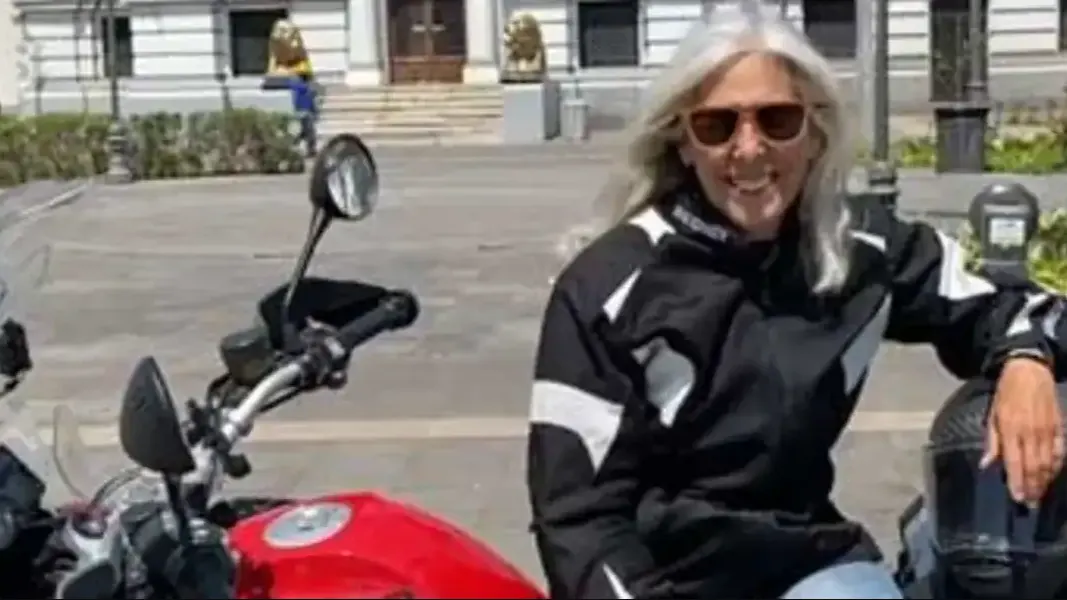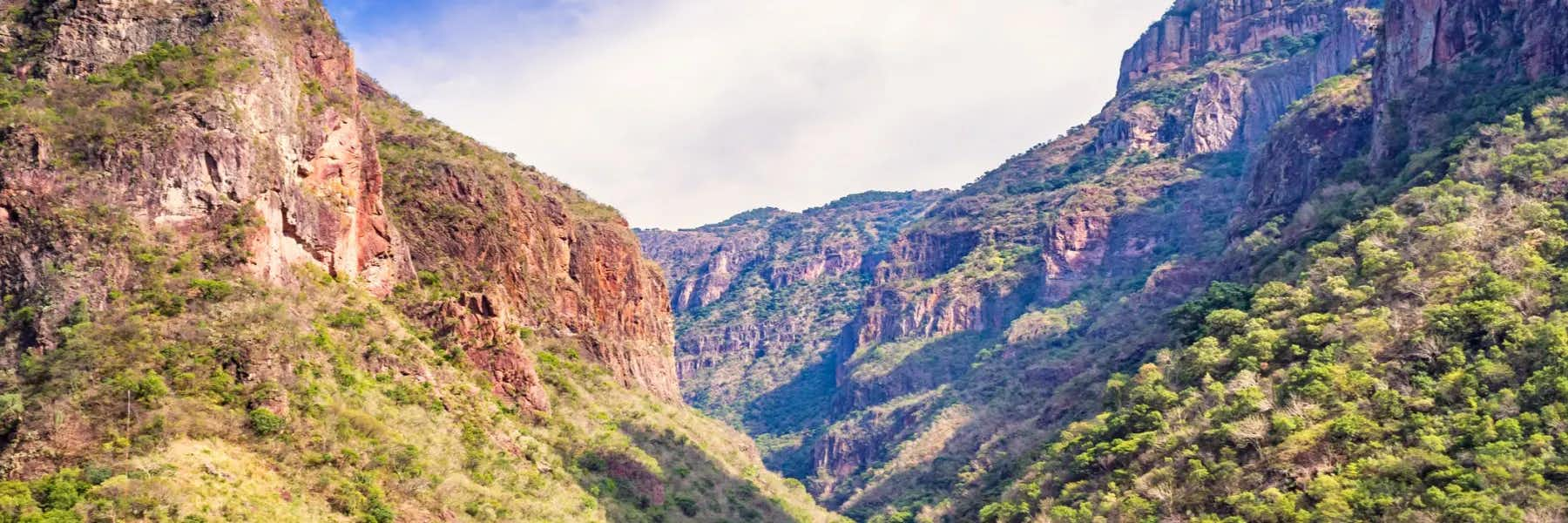I love outdoor travel and consider myself pretty well-versed in exploring nature’s magnificent beauty. But I wasn’t prepared for the stunning grandeur of Copper Canyon, also known as Barranca del Cobre.
Riding Copper Canyon on a motorcycle is on every biker’s bucket list, and I was no exception. But here’s the good news for everyone else. The Chihuahua-Pacific Railway is a passenger train (El Chepe), that runs through the heart of the canyon offering an easy and flexible way to see the area. If we weren’t on our three-month motorcycle trek (read more about that here), I would have, hands down jumped on that train.
We purposely arranged our itinerary to include Copper Canyon, located in the state of Chihuahua (not far from the Texas border), in north-central Mexico. Having been on the road for almost two months by the time we got to the canyon, we felt pretty savvy on how to negotiate Mexican roads. Our driving skills got sharpened on the many narrow roads and switchbacks as we navigated through the interior and into the bottom of the canyon. While this is an amazing route to drive, be aware there are sheer drop-offs down thousands of feet and barely enough room for two vehicles in many areas, not counting the goats and cows. If you find that exhilarating, then getting your own rental car might be an ideal choice. If not, the train still gives a wonderful panoramic overview and the ability to get on and off at various towns for further exploration.
Speaking of towns, there are a few scattered about and we stayed in three of them: Creel, Batopilas, and Urique, the latter being located at the bottom of the canyon. Creel is at the northern point of the canyon, a station stop for El Chepe, and definitely geared toward tourists with many small hotels, restaurants, and adventure guides. We stayed at a hotel slightly off Main Street and just happened to be there while they were holding a Temazcal ceremony. Temazcal, is common in certain areas of Mexico and I would describe it as a spiritual and bodily cleansing ritual (that involves a lot of sweating). Our ceremony, led by a Shaman-like woman, started with a forest walk paying homage to the sun and the moon. We then moved to a sauna-like cubicle where 10 of us huddled around a pile of steamy rocks and gave our intentions for personal growth, and happiness. I particularly liked the slathering up with mud which, once rinsed, results in silky, smooth skin.
One of the most culturally interesting aspects of visiting all the towns is the presence of the Raramuri people. These indigenous people, live throughout the canyon in very primitive housing or caves and still farm with oxen and plows. It was like a step back in time to watch them, in traditional dress, working the fields but also in town selling handmade trinkets to tourists. They are also known as the Tarahumara and you may have heard of their long-distance running abilities. Living in remote locations means they are accustomed to walking for miles, and they wear a type of minimal sandal that would leave most of us stranded with very sore feet. Experiencing different cultures like this firsthand is what makes travel so enriching, in my opinion.
Get Your Free Mexico Report Today!
Get Your Free Mexico Report Today!
Learn more about Mexico and other countries in our daily postcard e-letter. Simply enter your email address below and we’ll send you a free special report – Mexico: The Perfect Close-to-Home Retirement Haven.

By submitting your email address, you will receive a free subscription to IL Postcards and special offers from International Living and our affiliates. You can unsubscribe at any time, and we encourage you to read more about our Privacy Policy.
The perimeter of the entire canyon has decent blacktop roads and a thrill-seeking afternoon can be had by stopping (by train or car) at Divisadero, a bit of a theme park for adrenaline seekers. Zip lines and cable cars, have you suspended high above the canyon for spectacular views or you can test your fortitude on a climbing expedition. Once your heart rate has leveled back to normal, consider checking out Batopilas. A small town of just 1,200 locals, reached via a white knuckle road, Batopilas was also a step back in time. Though everyone has a cell phone, what they don’t have is a gas station. So, you knock on a door where there is a “gasolina” sign, then a hose or a bucket of gas appears from somewhere to fill ‘er up. A town like Batopilas is for wandering around, not for doing anything in particular or buying souvenirs. Chatting with the locals in the town plaza, watching the kids swim in the river, enjoying a mango with a shop owner, and eating in the few restaurants that feel like a home kitchen because, well, they are. It’s for relaxing and admiring the astounding landscape surrounding you.
We returned to the blacktop for a bit of backtracking in order to reach Urique, the bottom of the canyon. We had been warned by fellow bikers not to try the road connecting Batopilas with Urique, with our large bike loaded down with bags and the two of us. The extra miles were well worth it as we encountered the most dramatic vistas of the entire trip. Photos and videos don’t do justice to the vastness of this area or the intensity of the switchbacks as you approach the bottom. Again, it was a bit of a challenge for us with a heavy bike, but locals on motorcycles and trucks ride this route like a piece of cake. For as remote as it is, Bato (as it is nicknamed) is doable by getting off the train at Bahuichivo and then arranging for ground transportation.
Urique was like an oasis after a harrowing drive down, and we stayed at the only hotel with a pool, on the river with a bar and the ability to coordinate poolside massages. Just what we needed. While in Urique, we did some off-road driving to a nearby town to see an ancient mission church; so much of this area was settled by the missionaries. We decided to lighten our load when departing so I took the daily van service back up to the top, with all the bags, and Gary went it alone on the bike. As tricky as it may seem to get to Urique, Batopilas, or some of the other towns throughout the canyon, it can be done with the train in conjunction with a guide and a car or using an adventure travel service, most of which are based out of Creel.
If you’re thinking about using the train for primary transportation, realize there are two options. The nine-hour, tourist-focused El Chepe Express runs between Los Mochis and Creel with three to four stops along the route. You can ride straight through, but you’d miss a lot. Schedule your time to stay a few days in each location. The Chepe Regional runs from Los Mochis to Chihuahua City with more stops and is considered more of a local train. Both these trains only run certain days in each direction so you must check current schedules once your plans are firmed up. Getting to either of these starting points is not hard. Chihuahua City is about 500 miles from the Texas border, making this a feasible road trip. If you’re already in Mexico, Los Mochis has an airport with access from numerous other Mexican cities. Regardless of which train you take, the scenery will be simply spectacular, I promise.
We spent a good week exploring Copper Canyon and like most tourists, this interior part of Mexico wasn’t even on my radar. For most people, when you say Mexico they think of beaches, but Mexico has so much diversity to offer in its topography, culture, food, and weather. We had the unique opportunity to spend three months uncovering nooks and crannies, which just can’t be done within a typical vacation. So, yes, I’m a Mexico convert. So much so that we’re planning to spend several months next winter really digging into two of our favorite towns, Oaxaca and Puerto Escondido. The Copper Canyon area is not anywhere I want to live, but absolutely, without question, should be on your list of adventure travel is your thing.

Donna Shields, MS, RDN was bit by wanderlust some 30 years ago and is still on the road. With numerous worldwide home exchanges under her belt, she splits her time between Key West and Colorado while not gallivanting elsewhere.
Years as a food and nutrition writer means she’s always sniffing out the good eats and seeking the next hidden gem of a town to visit. Her recent 10,000-mile motorcycle trip through Mexico led to a new travel blog, Open Mind Adventure. She’s out to prove that over 60 doesn’t mean the adventure is over.
Get Your Free Mexico Report Today!
Get Your Free Mexico Report Today!
Learn more about Mexico and other countries in our daily postcard e-letter. Simply enter your email address below and we’ll send you a free special report – Mexico: The Perfect Close-to-Home Retirement Haven.

By submitting your email address, you will receive a free subscription to IL Postcards and special offers from International Living and our affiliates. You can unsubscribe at any time, and we encourage you to read more about our Privacy Policy.
Related Articles
Top 10 Reasons to Move to Mexico
